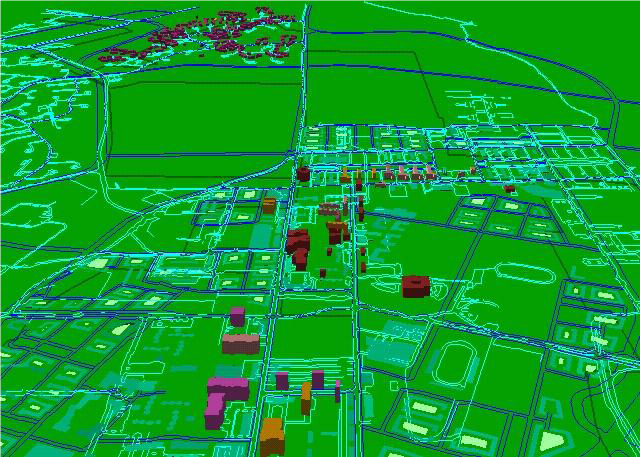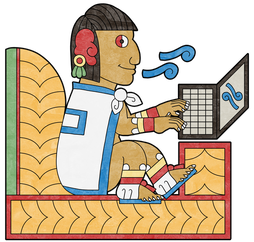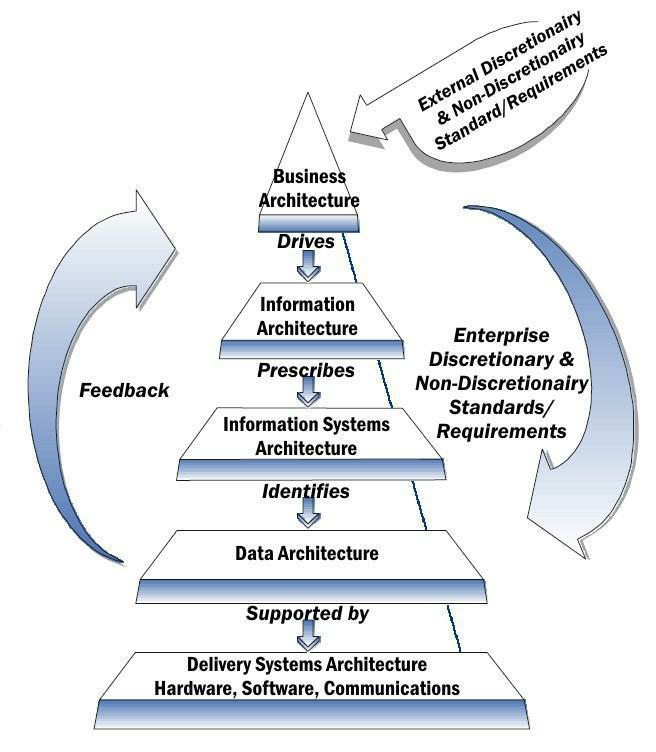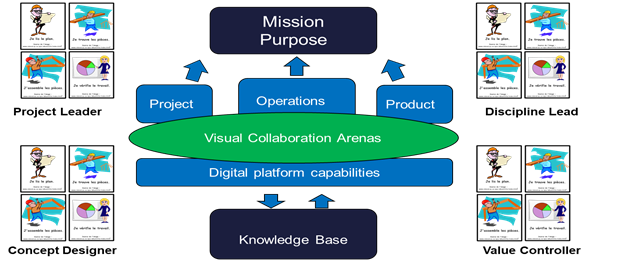Using e-Enterprise Architecture and Systems Engineering to Stoke the Interests of Chicano/Latino Youth in STEM Fieldsby Armando Arias, Ph.D. One year ago, Somos en escrito Magazine published an earlier version of this article by Professor Arias on the subject of Enterprise Architecture centered on a systems engineering approach to designing Active Knowledge Models for institutions of higher education. This article not only revisits ideas from that article, but also builds on the most recent technological developments in the field of Enterprise Architecture/Systems Engineering as well as explores how Active Knowledge Models can support the entire collegiate journey of Chicano/Latino students in American society today.  This is the first aerial picture digitized into an image at the start of CSU Monterey Bay in applying Enterprise Architecture to create an Active Knowledge Model for the purposes of transforming Fort Ord into a university. Professors of engineering from El Colegio de la Frontera Norte were trained to create an EA-AKM model. This is the first aerial picture digitized into an image at the start of CSU Monterey Bay in applying Enterprise Architecture to create an Active Knowledge Model for the purposes of transforming Fort Ord into a university. Professors of engineering from El Colegio de la Frontera Norte were trained to create an EA-AKM model. It is through the use of e-Enterprise Architecture, an advanced form of systems engineering, that I suggest an overall Information Technology (IT) strategy, while at the same time moving both IT and instructional systems beyond traditional ways of creating, transforming, managing, and administrating institutions of higher education (IHE) through the application of active knowledge models (AKM) all in support of the entire student journey. The COVID-19 virus pandemic of 2020 caused a sudden cognitive shift in American society in how it is that both traditional state-supported university systems as well as private colleges offered instruction by suddenly requiring online teaching, learning, research and administration almost overnight. The shift to online instruction (namely the utilization of virtual online learning platforms as a lecturing tool, plus a variety of LMS platforms came suddenly and the majority of institutions of higher education (IHE) were simply not prepared, nor were administrators (see “The Chronicle Review: University Leaders Are Failing. The pandemic reveals ineptitude at the top.” The Chronicle of Higher Education, May 19, 2020, see, https://www.chronicle.com/article/university-leaders-are-failing/248809. In short, the manner in which the pandemic caused a rapid shift to online instruction and virtual administration is the core example of how institutions of higher education got on with their business of managing their universities/colleges. At the same time and due to the emergency situation, there was a cognitive shift away from following policies and rules about which tasks could or could not be completed online (away from the university), especially since physical plants were closed to students, staff, and faculty. Interesting to note is that the stigma often applied to non-traditional universities (i.e., University of Phoenix, etc.) was swept under the proverbial rug, at least for now. Moreover, the pandemic caused a good deal of rapid technological change not just for teaching, learning and research but especially for how to manage and administrate institutions of higher education. Interesting to note is that most university administrators were not skilled nor experienced to manage the impact of rapid technological change of this sort. Nonetheless, we (taxpayers, stakeholders, etc.) need to hold administrators of especially state supported institutions of higher education accountable for misspending state funds, especially funds related to IT and their handling of issues directly related to the pandemic no matter how rapid they occur. The pandemic also caused a cognitive shift in how it is that people in American society (and in the world for that matter) think about the value of a college education and to become more open-minded about how to achieve education in systems that are broken as is so aptly stated: “Everybody agrees that our higher education system is broken. They might disagree about what needs fixing first. But everyone is aware of the brokenness.” Michelle Jones, founder of Wayfinding College in Portland, Oregon, see https://hechingerreport.org/as-enrollment-falls-and-colleges-close-a-surprising-number-of-new-ones-are-opening/. I argue that through the application of Enterprise Architecture and active knowledge models we can not only come to see what is broken in systems of higher education, we can also prioritize “what needs fixing first” especially since AKM demonstrates the value every individual brings to an enterprise (university/college). I see this as an opportunity to suggest an even larger shift in how higher education “gets done” through the use of Enterprise Architecture (EA) through a combination of IT and Systems Engineering beyond what most college/university administrators can currently comprehend. This book provides a blueprint for how it is that EA is the most advanced tool of our time to manage rapid technological change today and in the future. I will layout a blueprint and suggest how IT improvements can remain efficient and accountable to stakeholders (taxpayers, students, and parents). Also suggested is a plan for radical transformation of what constitutes an institution as part of the higher education-system and how to better serve educationally underserved student populations. Let me be clear. I am not here to discuss whether or not the shift to online instruction is being assessed and/or evaluated or whether important workload policies are being followed; we can and should take those topics up elsewhere. Rather, I am here to suggest new ways of knowing the idea of a multi-university (“thinking university-system”) predicated on the idea of a university-system as an e-enterprise where all things in the enterprise are linked and connected at all times in real time. With such an EA design and the application of active knowledge models, rapid changes like pandemics can be managed in the most appropriate manner possible with or without leadership that can see this vision. Evidence of what I am pointing to and experiencing in American society today is captured in a series of reports published by The Chronicle Store, for instance:
Active Knowledge Models & e-Enterprise Architecture Can Help Stoke the Intellectual Imagination for Chicano/Latino Students to Enter STEM Fields I propose the development of a capability for enterprise architecture (EA) for large-scale state university systems that are designated as HSIs (Hispanic Serving Institutions). IHEs will include those with which I am most familiar such as Texas A&M University, Auraria Higher Education Center, California State University and the University of California. As part of our rendering a smooth IT transformation, our vision is to create outcomes-base special projects, while at the same time infusing active knowledge models targeting those universities in Baja California Norte where we trained in Enterprise Architecture when we started California State University, Monterey Bay. As part of the start-up team, we applied the METIS EA platform as the primary active knowledge model. We are targeting the following Mexican IHE as research and development partners because we have had collaborative success in our former projects while working under the auspices Mexico’s leading social and behavioral sciences institute, El Colegio de la Frontera Norte. In brief, we trained faculty from Mexican institutions of higher education that were part of the consortia I brought together in the form of BESTNET (Binational English & Spanish Telecommunications Network), to include Centro Estudios Technica y Superior located in Mexicali and the Instituto Tecnológico campuses located in Tijuana, Mexicali and Ensenada. See https://works.bepress.com/armando-arias/7/. Brand new small (start-up) private Latino colleges will also be considered when suggesting new virtual designs, such as Colegio Chicano del Pueblo (Virtual), the InterAmerican University as well as the new Sea Mar Chicano University in Seattle. Enabling HSIs Transformation to University e-Enterprises Enterprise architecture enables enterprises (herein: university-enterprises) to fully align administrative planning strategies with the technological infrastructures that support all of them. EA facilitates a university-system’s ability to communicate with all components that make up the entire system (academic departments, curricula, faculty, staff, students, and community partners, and much more) all at once in real time. At the same time, it will strategically align with whom it interacts allowing boundary-less information flow, more effective decision support and the alignment of administrative, application, data and instructional and university-enterprise transformation, effective communication structures and practices, multimodal communications, and the effective management of disruptive technologies. One definition of EA-based active knowledge models is that it is the organizing logic for all university-systems processes and IT infrastructure reflecting the integration and standardization and/or customized requirements of the university’s operation model, again, while remaining aligned with the university’s vision statement. (See basic AKM orientation at: https://akmclient-beta.herokuapp.com). In 2019, the University of California, San Diego turned out its first strategic plan in the history of the university; it provides a conceptual blueprint that defines the structure, operation, and goals of the university. It is an excellent plan for this vibrant (relatively young) university. As good a Strategic Plan as it is, it is stagnant in the sense that it is not linked to anything that provides real time data. Conversely, by using EA and AKMs as planning tools, the Strategic Plan could become a document connected to its university-enterprise in real time, constantly sensing, interpreting, reinterpreting, adding to and asking “What if?” scenarios of the ever changing landscape from things like budgetary, financial, research, and instructional perspectives to perspectives on core values from the vision statement. It has already been suggested that, in their quest to create “smart campus-communities” plans for said community in Baja California Norte, just 10 miles east of Tijuana (along Carretera 2000) that EA and AKM start the urban plans, see “A High-Tech Campus Community at the U.S.-Mexico Border” (Arias 2023) https://works.bepress.com/armando-arias/126/. What most university administrators don’t realize is that their strategic plans are in fact changing as they are producing the document; you might say “the document is obsolete even before it is completed.” It is important to note that the same goes for all other planning that is stagnant (not linked to real-time data). This would have been an opportune time for UC San Diego to apply EA to its strategic planning. My point is that once realized, EA will change the nature of their planning. A major intent of EA and active knowledge models is to determine how a university-system-enterprise can most effectively achieve its current and future objectives—in real-time—between the relations found in AKM models. “Years ago, it was the idea of Viable Systems Models (VSM) developed by Stafford Beer that first acted as an aid to the practical process of diagnosing all problems in human organizations and helping to improve their functioning. Stafford believes that effective organizations should maximize the freedom of their participants, within the practical constraints of the requirement for those organizations to fulfill their purpose. He believes that the science of cybernetics can be used to design organizations that fulfill these objectives. The VSM is intended to act as an aid to the process of diagnosis of organizational problems, and the subsequent process of organizational re-design. The re-designing process should use technology, particularly information technology, to assist in providing organizations with a nervous system which supports their aims, without the burden of bureaucracy.” From Stafford Beer’s Viable System Model: An Interpretation by Trevor Hilder © Cavendish Software Ltd. 1995, portions © Stafford Beer 1985. In the past few years, only a handful of major university-systems have developed university-enterprise architecture; MIT applies EA across their system, while the University of California system applies it for partial system-wide administration. That is why UC San Diego did not apply it in the development of their Strategic Plan. This is the case because the University of California views EA as a topic for research and development as an experiment, not quite yet an application, if you will. Interesting to point out is that in a recent announcement (2022) about changing the name of California State University, Humboldt to a “polytechnic university,” Cal Poly Humboldt will now focus on the STEM fields (science, technology, engineering and mathematics). They may now be poised to incorporate EA and active knowledge models as it was only a year ago they were reportedly considering reorganizing the university to cut a number of programs due to financial woes. Last year (2021), Gov. Gavin Newsom approved a $458-million investment for the expansion of Cal State’s STEM initiatives. In addition to the re-designation of Humboldt, the funding included $25 million to launch a technology hub at Cal State Northridge intended to draw Latinos and traditionally underserved students into STEM fields. (Los Angeles Times, February 23, 2022). The University of California has developed its own system-wide Enterprise Architecture BoK–Body of Knowledge as a “repository of assets including guidelines, principles, reference architecture and standards, that have been reviewed and recommended for use. System-wide use of these assets increases the interoperability and reuse potential of technology investments made, thus improving overall efficiency.” In addition, EA involves administrative process reengineering and alignment with the technological infrastructure needed for such improvements. Note: This will prove critical as we prepare for the overall impact of pandemics and new conversion forms of university-systems. The significance of university-enterprise architecture is demonstrated in moving from the idea of a university that adapts new technologies to a new paradigm for looking at transforming it to a thinking system, notably:
More than ever during the time of a global pandemic, we have the opportunity to rethink the idea of the university and add integrated diversity wherein minds that are connected (stakeholders) administrate behind the scenes through an integrated model for all to see at all times. It is through the application of Enterprise Architecture, IT, and Systems Engineering that act as the infrastructure designed to create real-time “What if?” scenarios that respond to rapid social change, such as pandemics. From a teaching, learning and pedagogical perspective, I am suggesting a new “thinking university system” that will re-make universities as organizations and institutions into a new form of housing the production of knowledge to be taught to future students. It is important to note that I am not suggesting that this design be driven by Artificial Intelligence but will also have real-time (live) ongoing input from humans and algorithms based on human behavior. Important to note is that this approach will not employ a business model as is the case of current universities, hospitals, police departments, corporations, etc., but rather an approach that takes into account the real values and beliefs of its constituents and stakeholders. Beyond providing new pathways for teaching and learning, this approach will assist in downsizing the physical plant of traditional universities, restricting operating budgets, setting priorities in curriculum and academic specialties and most of all finding new modalities for the actual imparting of knowledge in a professor-student relationship, etc. The new innovative thinking university-system of the future (the one being proposed) will at all times incorporate input of actual faculties in defining the role of the future of universities. Keep in mind that much larger universities (as found in the California State University System) found it difficult to reconcile the new approaches to teaching that were practiced briefly and planned as alternative pedagogical models. In this way, EA can assist universities in transforming entire university systems. It can be applied to complex organizations to create “What if?” scenarios that assist each and every stakeholder know how it is they are a part of the university (enterprise) and how they contribute to the overall vision of the university as demonstrated in the diagram below. EA and active knowledge models are vital to all digital transformations and can assist university-enterprises. This design becomes the basis for the idea of a “thinking university” and would definitely call for e-architecting these new processes. [I made the same type of suggestion for the United Farm Workers to restructure their organization utilizing EA (see, Chapter Twelve: Reinventing the United Farm Workers through Systems Engineering and Enterprise Architecture in my book, Theorizing César Chávez: New Ways of Knowing STEM, Armando Arias, Somos en escrito Literary Foundation Press, 2020)]. In that chapter, I point out how I was introduced to EA when César Chávez turned down a rather lucrative offer to help the Boeing Corporation solve ongoing conflicts between union and non-union workers as he was at the height of the UFW Movement and could not assist. Instead, I gained insight into how to construct jet aircraft through the use of EA, that is, applying a model that brought together over two million parts, and thirty thousand people to create one jet aircraft. The problem you may not find comforting to know is that no two aircraft ever come out the same because parts and human behavior change over the build-out of the aircraft; this is the central idea I borrowed from EA and applied to building out brand new universities as an enterprise unto themselves. Case in point: During the manufacturing of passenger jet aircraft, Boeing could suddenly not acquire copper rivets for wing assembly from Zaire and had to go to Costa Rica for aluminum alloy rivets; the EA model could ascertain costs, weight, aerodynamic, training factors, labor costs, implications to contracts, and much more. EA has advanced tremendously over the years to a point where I began applying it to the rapid build out of brand-new universities. The relevance of EA and AKM to universities is that: Systems engineering is an interdisciplinary approach and means to enable the realization of successful systems. It focuses on defining customer needs and required functionality early in the development cycle, documenting requirements, then, proceeding with design synthesizing and system validation while considering the complete problem: Operations, Performance, Test, Manufacturing, Cost and Schedule, Training and Support and Disposal. Systems engineering integrates all the disciplines and specialty groups into a team effort forming a structured development process that proceeds from concept to production to operation. Systems engineering considers both the business and the technical needs of all customers with the goal of providing a quality product that meets the user needs. Definition of the International Council on Systems Engineering (INCOSE). Moreover, the benefits of integrating systems engineering and enterprise architecture based on active knowledge models as applied to the build-out of jet aircraft to entire university systems are many. As aforementioned, I first learned about EA at Boeing and at the same time met senior members of the ARPANET project, precursor to the Internet. As a direct result, I founded BESTNET (Binational English & Spanish Telecommunications Network) and we ran parallel human factor analysis experiments by creating communications knowledge models through DECNET as a tool for computer mediated conferencing, learning and group research and development and working together while apart. A more specific description of this type of work can be referenced in the Preliminary Phase of The Open Group Architecture Development Methodology. For more information refer to: http://pubs.opengroup.org/architecture/togaf9-doc/arch/chap06.html. Advantages of EA Applications to Social and Behavioral Science Students Enterprise architecture (EA) will:
EA is only a tech-tool to be sure, but it is also the most effective tool to date to cause an ongoing sparkling interchange of innovative ideas between very different types of people and start and/or transform institutions of higher education. Moreover, in all of the technological capabilities that exist today there is no better tool than EA to cause a confluence of knowledge. A Sustainable Design for Higher Education Transformation Active Knowledge Modeling (AKM) and digitalization support the capture and management of enterprise knowledge and data, creating digital models of human mental models for more effective and sustainable design, operations, and cyclic reuse. Human mental models are captured and enhanced by practical collaborative innovation and learning, modelling novel concepts and approaches to products, processes, and properties and methods. Digitalization and AKM capabilities enable cyclic design and operations of instructional science and technology models and work-processes, collaborative innovation and learning, and creation of sustainable instructional, collaborative research and workspace solutions. Background Active Knowledge Modeling (AKM) were first applied in a university setting in 1994 upon the founding of California State University, Monterey Bay (CSUMB) while utilizing the METIS platform, created by Frank Lillehagen, in Salongbakken, Norway. As members of the start-up team to initiate a new university, Armando Arias, Ph.D., Founding Dean/Founding Associate Vice President and Beryl Bellman, Ph.D., Academic Director at the FEAC Institute, co-founders of BESTNET (Binational English & Spanish Telecommunications Network), acquired METIS resources and tools and trained engineers from El Colegio de la Frontera Norte (COLEF), see, https://works.bepress.com/armando-arias/4/. At the same time, Arias and Bellman garnered research support from the Western Behavioral Sciences Institute (WBSI) in La Jolla, California where BESTNET was located for over a decade. Working collaboratively, METIS staff trained faculty/staff from CSU Monterey Bay, BESTNET, COLEF, and WBSI. Together they invested in novel capabilities for modelling reusable collaborative infrastructures, services, and instructional, collaborative research, teaching, and learning workplaces. Industrial solutions for university design based on the prototype for creating new universities through object-oriented enterprise modeling and the applications of communications knowledge management (now the AKM Modeler) were implemented and demonstrated for institutions of higher education, research and development institutions, and university construction industries for the development of brand-new colleges/universities. The following journal articles by Arias and Bellman provide additional insights: Object Oriented Enterprise Modelling & Distributed Cognition at a New University: The Case of CSU Monterey Bay, describes in detail how METIS was applied in starting a brand-new university, see, https://works.bepress.com/armando-arias/7/; Creating a New University Through Object Oriented Enterprise Modeling, focuses more on how EA modeling infuses the strategic planning process to create an overall vision for the university, see, https://works.bepress.com/armando-arias/5/; and, the article, Agile Learning, New Media, and Technological Infusement at a New University: Serving Underrepresented Students, describes how METIS is applied not only to starting a brand new university but also in serving underrepresented students, see https://works.bepress.com/armando-arias/20/. Since the founding of CSU Monterey Bay and as the application of the METIS platform industrial digital markets matured, only one new small-scale application was initiated at the University of California, San Diego (UCSD). In early 2022, we held a series of meetings, with active knowledge model scientists in Norway. As a direct result and infusing the lessons learned, we started reanalyzing use-case modelling which used the early version of the AKM Modeler, METIS. The initial focus was on use-cases for transforming Fort Ord, the world’s second-largest U.S. military base, into a university. In short, we learned about the practical needs and challenges, as well as potential capabilities and outcomes of AKM modelling. The mutual innovation, operations and learning included quite a few lessons learned for all parties. The figure below shows the scope of work for some of the roles of the project teams. Any sector implementation effort should start with a pilot project. We are viewing the case of CSU Monterey Bay as our pilot project, and scoped use-cases involving selected domains for higher education, collaborative partner and clearly stated outcomes/deliverables, and cyclic design and operations. Designing use-cases and modelling roles and instructional workspaces, and collaborative workplaces and research needed for sustainable operations is cyclic innovation and learning for all involved. Teams will serve the purpose of the mutual learning among partner roles and AKM modelling experts. Early prototype solutions and practical use-case demonstrators are produced, removing doubts and creating proven approaches and methods, and a solid understanding of the AKM modelling and meta-modelling concepts and challenges. Active Knowledge Models for Higher Education In order to ensure sustainability, AKM models must be developed for institutions of higher education, related research and development industries and the public sector. These models must embrace societal laws and technologies, practices of markets, communities and societies and partner dependencies. Innovation projects should find partners that can be Sector-specific Platform responsible operators and appoint partners that will be market and society responsible for AKM outcomes that cause social change by design. Opportunities for Research and Development for Institutions of Higher Education: Platforms, Components, Outcomes-Based Teaching/Learning and Services Institutions of higher education are invited to form platform design and operation teams composed of administrators, faculty, staff, students, IT builders, users, and operators. This novel opportunity, created by advances in digitalization and AKM modeling offer collaboration, interaction and cyclic design and operations across life-cycle disciplines. Novel capabilities and services in fabrication, commissioning and operations will enable sustainable and profitable outcomes-based solutions and services. 1. The core AKM platform is adapted to applying AKM’s modelling tools. Most categories of knowledge models and meta-models are initially modelled by the Open Source AKM tools and can later be developed and applied by collaborating customers and leading partners. 2. Most sector-specific AKM models will be developed, supported, and managed in a sector-specific AKM e-architectures. 3. Utilizing e-architecture tools will be designed for digital data services, capturing, ingesting, and managing big data, performing analyses, and developing new methods. Users will collaborate to create their real-time product and process monitoring tools and will develop special methods and services to be integrated and delivered to their sector. 4. Active Knowledge Modelling – for novel object types, properties, and outcomes-based services. Users will be offered AKM models, meta-models, and services to capture new concepts, properties and values exploiting partner and supplier knowledge and data. Sustainable methods will be delivered across sectors. 5. Active Knowledge e-Architectures – generic, as well as sector- and educational-specific e-architectures will be developed over the coming years. Each sector will build best-practice reference e-architectures (based on lessons-learned) for each respective project in support of the delivery and operations of responsible deliveries that meet clearly stated outcomes. Future Vision for Active Knowledge Models What I am proposing and at the same time envisioning for the future of transforming Hispanic Serving Institutions is the creation of web-based visual collaboration arenas for teaching, learning, research and development and administration of a new form of university-enterprise enabled by evolving sustainable sector platforms and customized active knowledge models designed through the application of e-architecture platforms like METIS. AKM teaching and learning workplaces and services will integrate and extend the use of AKM-driven ICT systems. In a similar fashion as we did when starting-up CSU Monterey Bay and while working in collaboration with El Colegio de la Frontera Norte (Mexico’s premier social and behavioral sciences institute, we will once again be positioned to begin immediate research and development in the application of active knowledge models and e-Enterprise Architecture. We will propose a pilot project for reorganizing higher education in the State of California (University of California/California State University) and also in both private and public university systems in Baja California Norte: Centro de Enseñanza Técnica y Superior and the Instituto Tecnológico. The initial core AKM Platform will be composed of open generic digitalization tools and to be applied through binational collaborations. We will collaborate to design Hispanic student services, and teaching, learning and research solutions, that are bicultural, bilingual and transnational, especially designed for serving educationally underserved student populations.  Armando Arias, Ph.D., was part of the start-up team and founding member of California State University, Monterey Bay, where he now serves as a professor in the division of Social and Behavioral Sciences and Global Studies. He is the author of the international award-winning book, Theorizing César Chávez New Ways of Knowing STEM, Somos en escrito Literary Foundation Press, 2020, in which he shares a critical analysis of STEM studies, portraying his views as César Chávez would have had he gone on to earn a doctorate in science. He has served as a start-up team member for more than a dozen new universities in the U.S. and consulted on the founding of new universities in Japan, Mexico, Europe, and Africa.
0 Comments
Your comment will be posted after it is approved.
Leave a Reply. |
Archives
June 2024
Categories
All
|
Donate and Make Literature Happen
is published by the Somos En Escrito Literary Foundation,
a 501 (c) (3) non-profit, tax-exempt corporation. EIN 81-3162209






 RSS Feed
RSS Feed